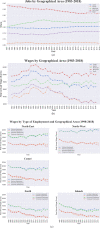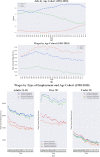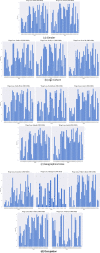Vanishing social classes? Facts and figures of the Italian labour market
- PMID: 36415649
- PMCID: PMC9668399
- DOI: 10.1007/s00191-022-00793-4
Vanishing social classes? Facts and figures of the Italian labour market
Abstract
This paper analyses medium-term labour market trends from 1983 to 2018 in Italy relying on the "Rilevazione dei contratti di lavoro" from INPS archive which provides information on average salaries by professional category, age, gender, and geographical origin. Within an overall pattern of exacerbated wage inequalities, documented by means of different indicators, the empirical analysis highlights how the within-component of the wage variation prevails in the gender, age and geographical dimensions. By contrast, the between-component in terms of professional categories (trainees, blue-collar jobs, white-collar jobs, middle managers, executives) is the only between-variation attribute to prevail, corroborating the role played by a reduced class schema, excluding capitalists and the self-employed, in explaining wage inequality. Regression-based inequality estimations confirm the role played by managerial remuneration, the contradictory located class, in driving divergent patterns. Stratification of wage losses is recorded to be largely concentrated among blue-collar professional categories, women, youth, and in Southern regions.
Keywords: Inequality; Occupations; Wages.
© The Author(s) 2022.
Conflict of interest statement
Ethical conductThe authors have no conflicts of interest to declare.
Figures













References
-
- Acciari P, Alvaredo F, Morelli S. Measuring and understanding the distribution and intra/inter-generational mobility of income and wealth. University of Chicago Press; 2020. The concentration of personal wealth in Italy 1995–2016.
-
- Acemoglu D. Technical change, inequality, and the labor market. J Econ Lit. 2002;40(1):7–72. doi: 10.1257/jel.40.1.7. - DOI
-
- Acemoglu D, Autor D. Handbook of labor economics. Elsevier; 2011. Skills, tasks and technologies: implications for employment and earnings; pp. 1043–1171.
-
- Albertini M. The relation between social class and economic inequality: a strengthening or weakening nexus? Evidence from the last three decades of inequality in Italy. Res Soc Stratif Mobil. 2013;33:27–39.
-
- Alvaredo F, Atkinson AB, Piketty T, Saez E. The top 1 percent in international and historical perspective. J Econ Perspect. 2013;27(3):3–20. doi: 10.1257/jep.27.3.3. - DOI
LinkOut - more resources
Full Text Sources
